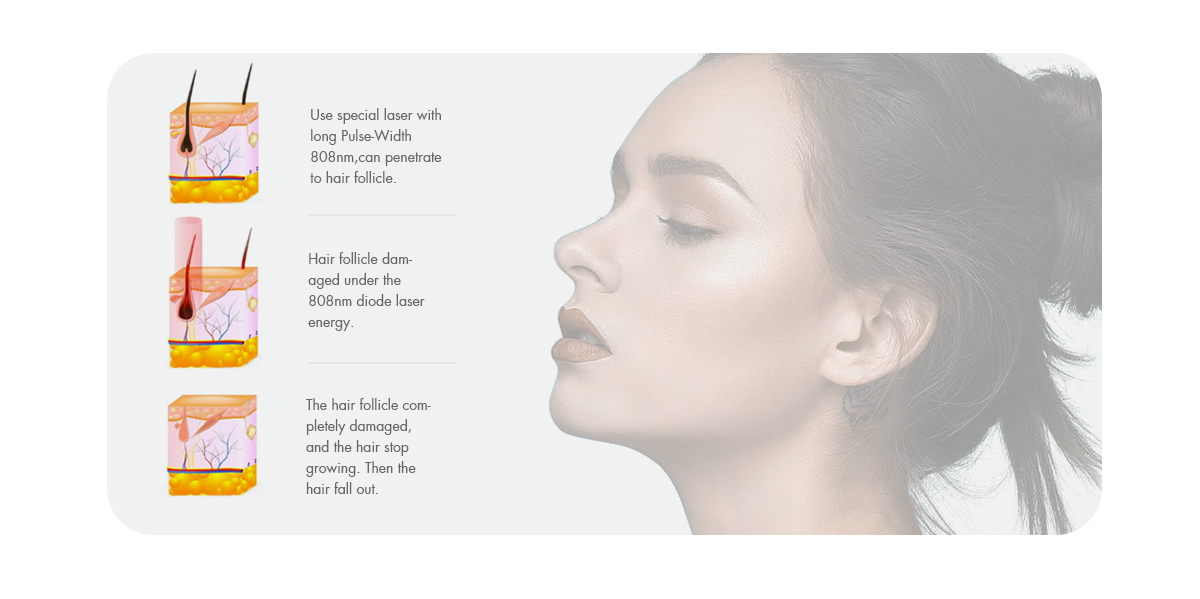Trying to understand all of the different types of laser hair removal machines can make your head spin. You've probably heard of a few key technologies, like diode, ruby, and alexandrite – but what do those terms mean, and how will they impact your laser hair removal experience and results? That’s what we’ll explain in this guide.

Diode Laser hair removal machine: The Gold Standard
1. Optimal Wavelength:
The diode laser machine operates at a wavelength of 808 nm, which is considered optimal for hair removal. This wavelength is highly absorbed by the melanin in hair follicles, allowing for precise targeting while minimizing damage to surrounding skin tissues. The 808 nm wavelength is effective for a wide range of skin types, including darker skin tones, making it a versatile choice for practitioners.

2.Deep Penetration:
The diode laser's wavelength allows it to penetrate deeper into the skin, reaching the hair follicles located in the dermis layer. This deep penetration ensures that the laser can effectively target and destroy the hair follicles, leading to long-lasting hair reduction.
3.Advanced Cooling Systems:
Modern diode laser machines are equipped with advanced cooling systems that protect the skin during treatment. These cooling mechanisms, such as contact cooling and cryogen spray, help to minimize discomfort and reduce the risk of burns, making the treatment safer and more comfortable for patients.
1. Alexandrite Laser (755 nm):
The Alexandrite laser operates at a wavelength of 755 nm, which is also effective for hair removal, particularly for individuals with lighter skin tones. However, it is less suitable for darker skin types due to the higher risk of pigmentation changes and burns. The Alexandrite laser is known for its fast treatment times, making it a popular choice for large areas like the back and legs.
2. Nd:YAG Laser (1064 nm):
The Nd:YAG laser operates at a wavelength of 1064 nm, which is less absorbed by melanin compared to the diode and Alexandrite lasers. This makes it a safer option for darker skin tones, as it reduces the risk of skin damage. However, the Nd:YAG laser may require more treatment sessions to achieve the same level of hair reduction as the diode laser.
3.940nm: Moderate melanin absorption and increased penetration. Perfect for dark hair whose roots are somewhat shallow.

4.. IPL (Intense Pulsed Light):
While not a laser, IPL is often used for hair removal. Lastly, there is intense pulsed light (IPL). Technically, IPL isn't a type of laser hair removal machine, since it emits light on a broad spectrum. Compared to laser devices, IPL is weaker and gentler, so it's popular for home-use devices. While it depends on the specific machine, IPL generally works on a more limited range of skin tones and often requires a greater number of treatments compared to lasers.

Sanhe Laser offers a variety of hair removal lasers with different wavelengths and power levels, including 1200W, 2000W, 1800W, and 3000W diode laser hair removal machines. They also provide single-wavelength and multi-wavelength comprehensive hair removal devices. I highly recommend the 3000W replaceable spot size 808nm diode laser hair removal machine. This machine features a single handpiece with multiple treatment heads, making it perfectly suited for all body treatments, whether it’s for upper lip hair, bikini lines, large areas like legs, or full-body hair removal. This 3000W replaceable spot size 808nm diode laser hair removal machine can handle it all, and it is compatible with all skin tones, making it suitable for any demographic.